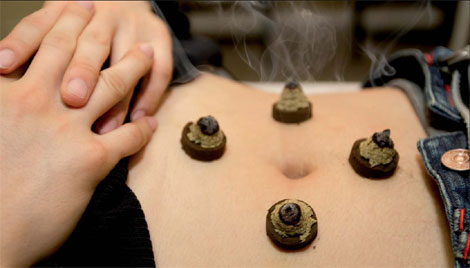Spot on
Updated: 2012-04-20 07:56
By Yin Yin (China Daily)
|
||||||||
|
Moxibustion is traditional Chinese medicine therapy that involves the burning of mugwort, a small and spongy herb, to promote healing. [Provided to China Daily] |
Ancient Chinese therapy draws on fire to provide welcome relief
Plagued by frequent bouts of rheumatic arthritis, Jessie Thiele Wright finally decided to turn to traditional Chinese medicine (TCM) at a hospital in Beijing.
"My illness seemed to have relapsed, maybe because I wasn't accustomed to the weather in Beijing. My friend suggested I try moxibustion - something I could also consider using at home," the middle-aged Briton says.
"I could smell the herbs from the burning cones applied to my trouble spots. My physician told me the aim was to invigorate the circulation of blood."
Thiele is among an increasing number of people in China and abroad who are discovering, or rediscovering, the benefits of moxibustion, a TCM therapy that involves the burning of mugwort, a small and spongy herb, to promote healing.
According to ancient TCM practice, the treatment is aimed at dispelling cold and dampness from the body, strengthening the blood, stimulating the flow of the qi energy channels and maintaining general well-being.
Historical records on moxibustion date back to the Stone Age, with the practice gradually came into being after the discovery and use of fire. Primitive people are said to have used burnt stones to treat diseases through local "hot compressions".
Healers gradually improved the technique using smoldering branches or plants to warm the affected parts of the body, giving rise to primitive moxibustion therapy.
During the Western Zhou Dynasty (c. 11th century-711 BC), practitioners settled on mugwort leaves as the standard herb in moxibustion.
Mugwort is used in the therapy in various forms, including compressed and smokeless sticks and cones. In TCM, mugwort is regarded as warm, positive and bitter when used in herbal prescriptions.
"Moxibustion is used on people who suffer from afflictions such as the common cold. Burning the moxa mixture in the therapy is believed to expel algidity and dampness from people as well as warm the channels of the body. Sometimes moxibustion therapy is considered to be a parallel therapy to acupuncture and is used in conjunction with it, but it depends on patients' conditions," says Zhao Ruizhen, a physician from the Third Affiliated Hospital of Beijing University of Chinese Medicine.
"There are two methods of moxibustion therapy: one is called the direct treatment where a small and burning cone-shaped moxa is placed on the patient's treated acupoint. This type of treatment is further categorized into two methods: scarring and non-scarring."
With the former, the moxa is lit and placed on an acupoint, and kept on the point until it burns out completely. This may lead to localized scarring and blisters, but after five to six weeks these will heal. TCM physicians say this can help cure some chronic diseases including asthma and tuberculosis.
In the non-scarring treatment, the lighted moxa is placed on the acupoint but is extinguished or removed before it burns off. The patient is expected to experience a comfortable, heat sensation that penetrates deep into the skin, without any pain, blistering or scarring unless the moxa is left in place for too long. This method can treat some cold-related illnesses, practitioners say.
"The indirect treatment is a popular method due to its much lower risk of pain," Zhao says. "It is used on a larger area, such as muscle groups. It is also the preferred therapy for children. Many special materials such as ginger, salt and garlic slices are used to separate the moxa and the skin."
In another form, the TCM physician lights a cigar-like moxa stick and holds it close to the affected region until the area reddens.
"Acupuncture is sometimes used in an indirect moxibustion treatment," Zhao says. "A needle is inserted into an acupoint and retained. The cusp of the needle is then wrapped in moxa and ignited, generating heat to the acupoint and the surrounding area. After the needed effect is achieved, the moxa is extinguished and the needles removed."
Moxibustion therapy can be used for a wider variety of health conditions, including chronic fatigue and diarrhea. But TCM fans consider the therapy to be extremely effective in treating arthritic conditions, especially joint pain when the condition worsens in cold or damp weather.
All that is in line with TCM theory. According to the theory, meridians and collaterals or pathways form the flow of qi and blood circulation, crucial parts of a specific network that communicates with the internal organs and limbs and connects the upper body to the lower regions.
"Generally speaking, moxa is used for conditions under 'cold' or 'stagnant' principles in TCM," says Francesca Le Goff, a French woman who has studied TCM in China for three years. "It is also helpful in strengthening the immune system as well as chronic low energy and fatigue, and cold hands or feet. Some painful conditions where moxa is helpful also include menstrual cramps and muscle pain."
Moxibustion practitioners say the moxa sticks used in the therapy are also widely available and convenient to use at home.
"You light one end and focus it onto a particular acupuncture point. You need the area to warm up, but not get too hot, based on your personal comfort level," Le Goff says. "Normally, you want to use the technique on multiple sides of the body for about one or two minutes per point."
TCM physicians say the therapy is safe, especially when it is carried out by a qualified and skilled professional. Some acupoints are not suitable for treatment due to the risk of dizziness or swelling, but the physician should be able to assess any risk factors before proceeding with the treatment.
Contraindications include yang, or positive, hyperactivity conditions such as hyperpyrexia or pharyngalgia, practitioners say. Pregnant women should avoid the treatment. Those suffering from too much fatigue, alcoholism and emotional instability are similarly unsuitable.
As the burning involved can produce a great deal of smoke and odor, patients suffering from respiratory problems may want to consider using smokeless moxa sticks.
yinyin@chinadaily.com.cn

 Relief reaches isolated village
Relief reaches isolated village
 Rainfall poses new threats to quake-hit region
Rainfall poses new threats to quake-hit region
 Funerals begin for Boston bombing victims
Funerals begin for Boston bombing victims
 Quake takeaway from China's Air Force
Quake takeaway from China's Air Force
 Obama celebrates young inventors at science fair
Obama celebrates young inventors at science fair
 Earth Day marked around the world
Earth Day marked around the world
 Volunteer team helping students find sense of normalcy
Volunteer team helping students find sense of normalcy
 Ethnic groups quick to join rescue efforts
Ethnic groups quick to join rescue efforts
Most Viewed
Editor's Picks

|

|

|

|

|

|
Today's Top News
Chinese fleet drives out Japan's boats from Diaoyu
Health new priority for quake zone
Inspired by Guan, more Chinese pick up golf
Russia criticizes US reports on human rights
China, ROK criticize visits to shrine
Sino-US shared interests emphasized
China 'aims to share its dream with world'
Chinese president appoints 5 new ambassadors
US Weekly

|

|








